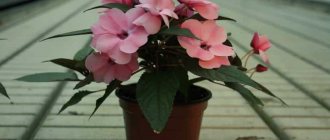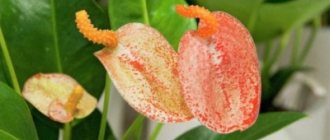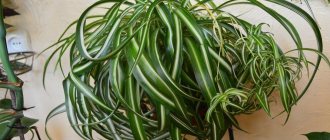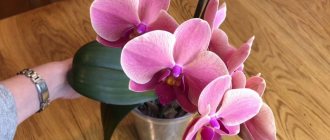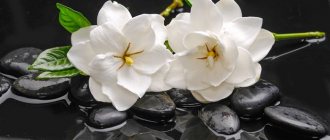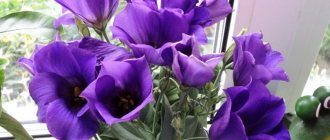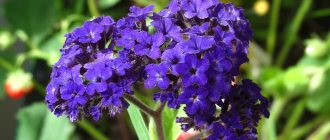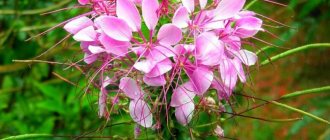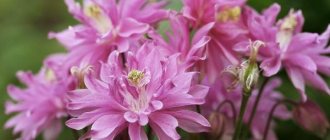Based on data from the encyclopedic Internet resource The Plant List, the Calathea genus includes 286 species. Each of them is incredibly beautiful and unique in its own way. This largest genus in the Marantaceae family was first described about three hundred years ago, but in the wilds of the South American jungle, new varieties of Calathea are discovered with enviable frequency. Breeders are also not in vain eating their bread, actively working on creating hybrids. Therefore, it is likely that The Plant List will again be replenished with spectacular positions in the future. In the meantime, let's look at the most common varieties that are adapted for care and cultivation at home.
Calathea bachemiana
Currently, this type is one of the most popular. Its natural habitat is the tropical forests of Brazil. Calathea Bachema is distinguished by its unpretentiousness when compared with other representatives of the genus. In addition, it has quite bright decorative features.
It has lanceolate leaves, without a petiole. Reaches 35 cm in height. The width of the leaves is about 7-8 cm, and the length is 15-20 cm. Towards the top they narrow sharply. They have a dense leathery structure. The upper side of the leaf blade is light green, with a bright silvery tint. There is a dark green border along the edge of the plate. The underside is somewhat darker and monochromatic. A characteristic feature of the species is a pattern of dark spots or stripes running along the central vein.
Cream flowers are located on short pedicels, the length of which does not exceed 2.5 cm, and are collected in small, about 6 cm in length, spike-shaped inflorescences. After flowering, the plant often loses the entire above-ground part, but after a while new shoots appear. But in indoor conditions, Calathea Bachema practically does not bloom.
Popular types of calathea
According to information available in The Plant List database, the Calathea genus includes 276 plant species. The most commonly grown ones at home are:
Calathea bachemiana
A compact plant from the forests of Brazil, the height of which does not exceed 35–40 cm. It has fairly wide (8 cm) and long (20 cm) leaves with a clear pattern. The upper side of the plate is light green with an attractive pattern of dark green spots extending symmetrically from the middle. The lower surface of the leaf is painted in a delicate lime color.
One interesting feature of Calathea Bachema: in the evening the leaves rise up, and in the morning they fall down, showing one side or the other. Thanks to this, the appearance of the plant changes throughout the day. It seems to be moving. It has large, spike-shaped flowers on short stalks.
Photo gallery
Calathea burle-marxii, or “Blue Ice”
This calathea has a rather unusual appearance due to its large and voluminous flowers, which are snow-white in color. Both the light green leaves and petals have a barely noticeable soft blue tint, which is why this species received its second name.
Calathea veitchiana
This plant is from the mountain forests of Peru. It is one of the tallest calatas, because an adult plant reaches almost a meter. Veitch's Calathea leaves are not far behind: they are up to 40 cm long and 15 cm wide. The upper part of the leaf plate is decorated with a contrasting pattern of dark and yellow-green shades with a glossy sheen. The underside is no less attractive - there is a pattern of white and yellow stripes on a green background with a purplish tint. White flowers, collected in spike-shaped inflorescences, are located on a long shoot (approximately 22 cm).
Calathea Insignis
This type of calathea is also called “Lanceolate” or “Lansifolia”. This plant looks quite impressive. Its long (up to 27 cm) leaves have a wavy edge, and the bottom is painted in a rich inky color with a purple tint. On the upper side of the leaf plate there is a clear pattern of dark green ovals on a lighter background.
Leopard calathea (calathea leopardina)
This is a small plant, the height of which does not exceed 40 cm. It has short (12 cm) and narrow (3 cm) leaves, on which, on a light green background, there are spots elongated from the center, vaguely reminiscent of spots on the skin of a leopard. The flowers are bright yellow.
Calathea lietzei
A medium-sized plant, the height of which is about 60 cm. The leaves, located on the petioles, are no more than 15 cm long and 8 cm wide. Their edges are slightly wavy. The upper side is glossy, shiny; it is painted in a bright green color, on which there are darker wide stripes. The lower one is red-lilac in color. The flowers are white.
Calathea Lubbersii
This species has a significant difference from the others: if the pattern on the leaves of others is quite symmetrical, then Lumberts’ calathea is an exception to this rule. Lemon spots are arranged in a chaotic manner on the bright green leaves. The leaves themselves have the shape of a regular ellipse, slightly pointed towards the top, and the bottom has a paler color than the top side. They are located on long petioles.
Calathea majestica
In floriculture, the 'WhiteStar' variety is common, distinguished by the original coloring of the leaves: narrow snow-white stripes, grouped by 4 into wider ones, flaunt on a green background. The leaves are wide, have a glossy shine, and are located on long petioles.
Calathea makoyana
A low-growing plant (up to 45-50 cm), with long (20 cm) and wide leaves. It has a bright pattern: the green background of the leaf plate is decorated with dark stripes that diverge from the middle and red spots. The underside of the leaf looks less colorful: it is almost transparent, pale green.
Calathea mix
This calathea is very similar in appearance and size to Zebrina. The only difference is that in Zebrina the pattern of light stripes is located on a dark background, while in Mix it is exactly the opposite, which makes it possible to distinguish these species from each other.
Calathea musaica
This calathea has a memorable color: bright green or light green veins divide the light leaf plate into quadrangles, making the color of the plant look like a mosaic.
Calathea orbifolia
A distinctive feature of this species is its wavy large leaves, similar to a fan. They have a dark color, decorated with light transverse lines.
Calathea zebrina
This variety has large leaves without petioles. The length is up to 40 cm, and the width is about 20. The leaf plate is painted in bright green colors, and the pattern vaguely resembles a bird’s feather. Thanks to this contrasting striped paint, this calathea got its name. The inflorescences have a round appearance and are located on short peduncles. The color of the petals is white or light lilac.
Silver Calathea (Calathea argyraea)
Silver Calathea (Calathea argyraea) is a compact plant with small leaves. A distinctive feature from other types is their silvery tint.
Calathea picta
Popular in indoor floriculture. It has elongated decorative leaves up to 20 cm long. The upper side of its leaf blade is painted in shades of dark green, the central vein and edges of which are light green.
Pink-colored calathea, or roseopicta (Calathea roseopicta)
This flower has a very attractive appearance, for which it is valued by gardeners. It has quite modest dimensions - for example, its height usually does not exceed 40 cm. Roseopicta is interesting because of the color of its leaves. Their upper side is dark green, on which there is a pattern of wide stripes and veins of various shades (from bright light green to silver and pink), and the lower side is dark purple. Along the edges of the leaf plates there is an almost snow-white border.
This species was subjected to selection, due to which various varieties of pink-colored calathea appeared. For example, this is Dotty, whose wide border and central vein are pink. The Little Princess variety is similar to it, but the latter has noticeably narrower pink stripes in the center and along the edges.
Calathea rufibarba
The name of this calathea translates as “red-bearded.” She received it due to the presence of a light red fluff on the underside of the leaf. It also decorates the petioles. The leaves are a uniform green color without a pattern, slightly wavy at the edges. Blooms yellow or orange.
Varieties of Calathea redbeard have been bred. For example, "Wavestar" or "Blue Grass". In the first variety, the lower part of the leaf is colored purple.
Calathea ornata, Sanderiana (Calathea ornata)
A miniature calathea, whose height does not exceed 30 cm. On long petioles there are lime-colored leaves, decorated with a pattern of pink and silver stripes. Sandarian inflorescences of white or lilac color flaunt on very long (up to 30 cm) peduncles.
Calathea lubbersii
This species is native to the tropics of Central America. Calathea Lubbersa can grow up to 80 cm in height. The leaves are large (up to 30 cm in length), quite wide. They have an oval shape and are located on long petioles. Also a distinctive feature of Calathea Lubbers is the asymmetry of the pattern. The main color of the leaf blade is bright green, with large spots of light green or light yellow on it.
Calathea of this species also stands out among others by the color of the underside of the leaf. It has a green tint, while in most species the underside of the leaf is painted in red shades. Has a uniform color, without spots. Often slightly lighter than the upper side. At home it blooms extremely rarely. The flowers are orange in color.
Flower propagation
There are two reliable methods of propagation: root division and cuttings. Growing flowers of the desired type and quality by sowing seeds at home is difficult, time-consuming and problematic.
To divide the roots, select a flower older than 3-5 years, and during the next replanting in the spring, the rhizome of the plant is divided with a disinfected sharp knife so that each part has a growing point, 2-3 leaves and formed roots. Delenki:
- planted in small bowls in a soil mixture of peat and sand (2:1);
- water abundantly.
The bowls are covered with plastic bags with holes made in them and placed in conditions of high humidity and temperature - 25-28 oC.
When a pair of new leaves appear on each division, they are transplanted into pots and placed in a permanent place. A year later they are transplanted again.
When cutting from an adult calathea, carefully cut off a healthy cutting so that it has a growing point and three to four leaves. Place in a pot with moist soil and cover with a plastic bag. Remove it and replant the cutting when it produces 3-4 roots.
Calathea lancifolia (Calathea lancifolia)
A popular species, characterized by rapid growth and relative unpretentiousness to living conditions. Natural habitat is tropical rainforests of Brazil.
The wonderful calathea reaches a height of up to 70 cm. The leaves are long and narrow, lanceolate. Their length rarely exceeds 25 cm. The width of the leaves is 3-5 cm. The edge of the leaf blade is slightly wavy.
Lanceolate calathea has bright decorative qualities. On top, the leaves are light green in color with a geometrically regular pattern of dark green ovals of small and large sizes, which alternate with each other. The underside of the leaf is dark burgundy, often mixed with a purple tint.
In indoor conditions, wonderful calathea blooms very rarely. The flowers of representatives of this species are small and inconspicuous.
Calathea zebrina
This species is native to the tropical forests of South and Central America. Zebra-shaped calathea is a fairly large representative of the genus and reaches up to 80 cm in height. In rare cases, it grows up to 90 cm. This herbaceous plant has large velvety leaves (about 30-35 cm in length) of an oval shape. Their width is 15-20 cm. The upper part of the leaf blade is bright green in color. The pattern consists of dark symmetrical stripes. Because of this striped pattern, the calathea received the name “zebra-shaped”. The underside of the leaf has a light green color without stripes; over time it acquires a beetroot tint.
The plant's pedicels are short. The flowers are white or lilac in color. At home it practically does not bloom.
Calathea warscewiczii
The natural habitat of this plant is Panama, Nicaragua and Costa Rica. Calathea Varshevich is one of the most demanding species. It needs a high level of humidity (about 80-90%), such conditions are difficult to create in an apartment, especially in winter.
Calathea Varshevich grows up to 1 m in height and in diameter up to 1.5 m or more. This species has large velvety leaves (20-55 cm) of rich dark green color and oval shape. The pattern is most often relatively weakly expressed and is a light green pattern in the form of short stripes located along the central vein. The reverse surface of the leaf plate is painted pale red.
One of the main advantages of Varshevich's calathea is that it blooms at home. The flowers, like those of other representatives of the genus, are collected in spike-shaped inflorescences.
The bracts are cream-colored. The color of the flowers can be white, soft pink or pale cream. You should know that before flowering, Varshevich's calathea forms elongated, crank-curved shoots, which require support to avoid damage.
Tropical calathea: home care with photos
The situation is simple: calatheas love light, but cannot tolerate direct sunlight, which leaves burns and fades the bright color of the foliage. They prefer diffused light in partial shade. Therefore, when looking for a window sill for a calathea, choose windows facing east, west or southeast, southwest.
If this is not possible, the flower is shaded for the period when direct sunlight falls on the windowsill. Or they are grown under fluorescent lamps, which also help out during the short winter daylight hours.
Temperature and humidity
Calatheas are warm and moisture-loving indoor plants, since they are still tropical in nature. They cannot tolerate temperature fluctuations or drafts. They love constant temperature conditions in their permanent habitat, so this place in the apartment must be determined in advance. During the growing season and flowering, the temperature is maintained at 24-28 ° C, in winter it is possible to reduce it to 18-22 ° C. At temperatures of 15 °C and below, the flower dies.
Calathea makoyana
Quite a popular look, despite its whimsicality. It is important to note that this calathea is not suitable for beginners. It is found naturally in the tropical forests of Brazil and other countries.
The height of plants belonging to this species does not exceed 50 cm. The leaves are oval in shape and reach up to 20 cm in length and 10 cm in width. Calathea Makoya stands out with its unique pattern. The main color of the upper side of the leaf is light green, often mixed with a silver tint. The edging of the leaf plate is dark green with torn edges. On the sides of the central vein there are oval elongated dark green spots. They come in different sizes. The lower part of the leaf has a reddish tint, its saturation can vary significantly. Unlike many other species, Calathea Makoya has a pattern on the lower part of the leaf blade, but the spots and edges are dark purple.
The petioles are long and straight, pubescent, and purple in color. Each rosette bears one photosynthetic leaf, surrounded at the base by several small scale-like leaves. The flowers are inconspicuous, small, and purple in color.
Planting calathea and replanting as it grows
After purchasing a flower in a store, the plant is replanted as soon as possible. The roots of calathea have such a feature as the release of toxins into the soil, and since it is not known for sure how long the flower has already lived in a store-bought pot, so as not to take risks, the plant is replanted both after purchase and subsequently as it grows. In the period from 1 to 3 years, transplantation is carried out annually, in subsequent years - once every two or three years. The time for transplantation is chosen in early spring.
Before planting, prepare the pot and soil:
- The pot will need to be shallow but wide, because a common feature of calathea is underground shoots that form a developed but superficial rhizome.
- The bottom of the pot is lined with a drainage layer as thick as one-fourth of the pot’s capacity.
- Pebbles or gravel are used as drainage, or brick chips can be used.
- The soil is prepared by mixing soil, peat and humus one to one.
- Calatheas need slightly acidic soil; wood ash is used for acidification.
- The finished mixture is poured into the pot, covering the drainage by 2-3 cm, and left loose without crushing.
Next they begin the transplant. Carefully, slowly, take the plant out of the old pot - without pulling the stems, take it out along with the earthen lump.
Note!
The rhizome is washed and inspected, all rotten, frail and damaged roots are removed.
Lower the flower into the pot, holding it, straightening the roots. Carefully fill them with soil, making sure that the growing point of the flower remains in the center of the pot and above the ground. The soil is moderately tamped down so that it settles and holds the plant, but is not compacted tightly. After all, the flower is watered abundantly and left in a shaded place for 2-3 days, the next watering is carried out only after 8-10 days.
Calathea roseopicta or Calathea medallion
This type of calathea is native to the northwestern part of Brazil, namely the tropical forests of Colombia, Ecuador and Peru.
The plant reaches 80 cm in height; at home it usually grows only up to 30 cm. Calathea roseopicta is extremely popular due to the wide variety of colors. Large oval-shaped leaves may be dark green or red in color on the upper side. On the upper side of the leaf plate there is always a bright pattern in the form of bright spots and stripes. The bottom of the leaf is usually purple. The petioles are long and purple in color.
The flowers of the plant also have a variety of colors, but they are quite small and are considered inconspicuous. The most common shades are white, purple and yellow. It must be taken into account that Calathea roseopicta is even more thermophilic than other representatives of the same genus. It blooms extremely rarely in indoor conditions.
There is a whole list of varieties belonging to this species. Moreover, some of them have external characteristics that are unusual for the species as a whole. For example, the Surprise Star variety is distinguished by the fact that the upper side of the leaves has a rich black color.
Diseases and pests of calathea
If home care is carried out incorrectly, the plant’s immunity suffers. Therefore, the following parasitic infections may occur:
- thrips - parasites reproduce at high temperatures, lack of moisture, white dots appear on the surface, and the insects themselves are localized on the back side;
- scale insect - the appearance of brown plaques on the surface;
- whitefly is a small insect with white wings, localized on the back side of sheets; during its life, it forms a sticky coating and reproduces well in extreme heat;
- spider mite - forms large white spots, cobwebs.
If the grower notices damage to the leaves and the presence of small insects, they immediately begin treating with insecticides. A signal for the presence of parasites can be a sticky coating or cobwebs. Aktara, Fitoverm, Actellik help well. Additionally, the surface is treated with a soap solution. It will help eliminate plaque and insects.
A large white coating may form on the surface of the bush. It is usually localized at the base, gradually spreading to the root. This indicates fungal growth. To eliminate pathology, fungicides are used. This is a powerful antifungal drug.
Calathea mosaic/Calathea Mosaica (Calathea musaica) or Calathea Network
This species is native to the tropical forests of Central and South America, India and Asia. A fairly unpretentious plant with unique leaf color. Requires lower humidity levels than other types.
The height of Calathea Network can vary from 30 to 70 cm. Representatives of this species have large, elongated leaves that are heart-shaped or spear-shaped. The main color is light green. The pattern of the plant is unique. The veins are clearly visible on the leaf blade and are dark green in color, creating the appearance of a mosaic. The pattern is also clearly visible on the underside of the sheet. The lower part has a pale green tint, without any admixture of red. The petiole is long and green.
Calathea mosaic rarely blooms at home. The flowers are white. Flowering usually lasts only a few days.
Calathea crocata
Calathea saffron is found naturally in Central and South America, as well as on the Tasmanian Islands. The height of representatives of this species is about 40-60 cm. The leaves are smooth, corrugated, oval in shape, and can reach 30 cm in length. The upper part of the leaf blade is bright green with a metallic tint, and the underside is painted a rich purple-red hue. The petioles are also colored red. There is no pattern on the leaves.
Calathea saffron stands out among other species for its regular flowering. With proper care, the plant blooms in January. The flowers are large and bright orange or yellow in color. Peduncles are very long.
It is important to note that this type is difficult to maintain. Calathea crocata is very demanding on humidity levels, so in most cases it is grown in greenhouses.
Calathea ornata (Calathea ornata)
Calathea ornate is found in the rainforests of Colombia. Under natural conditions, the plant can reach up to 1 m in height. However, at home, its height rarely exceeds 50 cm. Large leaves have an elongated oval shape and a glossy surface. The upper side of the leaf blade is rich green. The central vein is lighter than the rest of the leaf. Decorated calathea is distinguished by the presence of thin white or light pink stripes. The underside of the leaf is red, without a pattern.
Please note that as the plant grows, the pattern on the upper side of the leaves often becomes paler. The number of stripes on the leaves depends greatly on the calathea variety. You also need to understand that the plant almost does not bloom in indoor conditions. In nature, calathea adorned blooms with small, dark purple flowers collected in spikelets.
Growing and care
In order for growing calathea to be successful, you need to know about caring for it, then success will be guaranteed, and this unusual plant will decorate our home. A plant grown in an apartment grows up to 50 cm in width and height and can delight us for years. During the year it appears 5-6 new leaves.
Air humidity
Calatheas naturally grow in the tropics, where very high air humidity prevails. At home you need to provide conditions similar to natural ones. The higher the temperature, the more moisture there should be in the air. The optimal air humidity for calathea is 70%.
The ideal place for the plant would be a bathroom with a window.
It can also decorate the kitchen, which is often used for cooking, however, the flower does not tolerate kitchen fumes well, and the worst effect on it is combustion products generated from gas stoves - in this case, more careful care will be required.
In winter, when the heating system is operating, when the air becomes too dry, the tips of the leaves begin to dry out and turn brown. Too dry air blocks the formation of new leaves, old calathea leaves dry out. The plant needs to be sprayed regularly. In summer, spraying can be done daily; in winter, it is enough to spray every 2-3 days.
For spraying, use soft water that has settled for a day at room temperature. The pot can be placed in a large container filled with expanded clay or small pebbles and water.
Important: the bottom of the pot should not be immersed directly in water, otherwise the roots of the plant will rot.
If a humidifier is used, the plant should be placed closer to the device. This will give maximum humidity.
How to water correctly?
The frequency and abundance of watering should depend on the conditions in the apartment (temperature, air humidity), location, substrate used and the material from which the pot is made. Calathea must have a constantly moist substrate. Even a single drying of the root ball leads to irreversible changes.
The plant immediately reacts to improper watering:
- if you overdry the substrate, the leaves begin to wither and curl;
- The plant signals that watering is too intense by rotting leaves and rotting roots.
A drainage layer should be placed at the bottom of the pot to allow excess water to drain freely.
Calathea is watered with soft, settled water at room temperature. Tap water contains minerals and chemicals used by water treatment plants that can harm houseplants, especially calathea plants. It is better to use distilled water, you can collect rainwater. You can boil water and let it stand, then it will become softer.
Frequency of watering calathea:
- in the spring-summer period, when it is very warm, water 2-3 times a week;
- In winter, water once a week.
The soil in the pot should dry out a little between waterings.
Lack of water manifests itself as follows: calathea leaves curl into a roll.
Decorative leaves should be wiped regularly with a damp soft cloth. Due to the specific texture of the leaf blades, you should not wash calathea in the shower - this will lead to the appearance of unsightly stains.
Do not use special leaf polishing products! Dust should be wiped off with a dry soft cloth.
Fertilizers and fertilizers
Calathea during the growing season (from March to September) is fertilized once every 2-3 weeks. This very sensitive plant does not tolerate soil salinity, so we do not feed it too much. Excess calcium damages the roots of the plant, so it is better to feed it with vermicompost once every 2-3 weeks, only in the spring-summer season. Natural organic fertilizers of plant or animal origin will improve the chemical and physical properties of the soil.
In winter, fertilizing calatheas is completely stopped.
For fertilizing, it is better to use liquid multicomponent fertilizers intended for plants with decorative leaves. Use half the fertilizer dose recommended by the manufacturer.
Trimming
Beginner gardeners often ask, should they trim dead calathea leaves? Trimming or removing old or wilted leaves and flowers improves the plant's appearance and directs its energy to produce new leaves and flowers.
Preparing for winter
You need to prepare calathea for wintering gradually, acclimatizing it to changing conditions. For example, if the plant has been outside in direct sun, place it in partial shade or shade for a few days before bringing it indoors. It is normal for calathea to shed a few leaves after being brought indoors.
Transfer
Calathea is replanted in spring or June at least once every 3 years. Strongly overgrown, old specimens can be replanted every year. It is recommended to replant when it is clear that the roots have grown greatly. Untransplanted calathea leaves become smaller.
Deviations from the deadlines are used when necessary - replanting the calathea after purchase or because the pot is too tight. The new pot should be one size larger than the old one.
When replanting, you should not interfere too much with the root system. Therefore, we do not wash the roots, do not shorten them, or forcibly tear them. The only exception is a piece of rotten roots that must be removed. You only need to slightly loosen the root ball with your fingers to remove the old substrate.
Reproduction
During transplantation, you can propagate the plant. Calathea reproduces by dividing the rhizome; each new plant must have roots and shoots. The plant should be watered 2 days before the procedure so that the division occurs without complications.
The second way to propagate calathea is to root cuttings if a knot appears on the shoot, which is often called a knee. Usually nodes appear on the shoots after the plant has flowered, which begins to produce a lot of young leaves in this place. In the natural environment, the “trail” formed in this way falls to the ground under its own weight and takes root.
Calathea rufibarba/velvet calathea (Calathea rufibarba)
This species is sometimes called the "redbeard" because of its orange fur. Calathea rufibarba reaches 50 cm in height. Dense, elongated leaves are located on long petioles. The leaf blades have wavy edges, pointed towards the top. The upper side of the leaf has a rich green color, without any patterns. The lower part, in turn, is burgundy.
The main distinguishing feature of this calathea is the pubescence located on the petioles and the underside of the leaves. These hairs have a light red tint.
In its natural environment, the plant blooms with small creamy spike-shaped inflorescences. In Calathea culture, Rufibarba practically does not bloom.
Calathea loeseneri
It is found naturally in Peru, Brazil, Ecuador, Bolivia and Colombia. In nature, the plant can reach 1.2 m in height. Most often, this calathea is grown in greenhouses. The leaves are large, wide, lanceolate-shaped. They have a light green color without a pattern. The reverse side of the leaf plate is green. The central vein is often lighter than the rest of the leaf.
The plant is known for its small star-shaped flowers. They are located on long peduncles. The flowers in most cases have a delicate white-pink color. Less common are varieties in which the color of the flowers does not have a pink tint.
Calathea leopardina
The height does not exceed 50 cm. This plant has no stems. The leaves are oval, elongated. Their length is 12-15 cm. The width does not exceed 5 cm. The upper part of the leaf is light green. The pattern is represented by symmetrical oblong spots of dark green color connected to the central vein. The underside of the leaf blade is green. The flowers are collected in spike-shaped inflorescences and have a rich yellow tint.
Calathea leopardis is considered a fairly unpretentious representative of the genus. But you should know that this species is extremely demanding on regular watering.
Planting and propagation
If we buy a plant in a store, then we need to transplant it from a small pot to a medium one. We prepare the soil as described above. To allow air to pass through and moisture not to stagnate, we place drainage first, followed by soil. When replanting, we try not to damage the weak roots; water the soil in the pot well and carefully remove the flower.
For propagation, carefully separate the roots from the leaves, taking those that are located at the edges. We take a separate pot for each bush.
You can propagate by cuttings; to do this, cut off half the stem and plant it in moist soil, create a greenhouse effect, cut off a plastic bottle and cover the flower with the top part; a plastic bag is also suitable.
We remove the cover when the sprout sprouts roots. We do not touch the flower until four years old, and after that it is recommended to replant it every year.
Calathea Lietzei
The plant reaches no more than 60 cm in height. The leaves are about 15 cm long and 6-8 cm wide. The edges are wavy. The upper side of the leaf plate is green with a bright glossy sheen. It has wide dark green and silver stripes with torn edges. The leaves are pale red below.
Calathea Litze is relatively easy to maintain. The flowers are small, white or light cream in color. Unlike other calathas, representatives of this species form dense bushes under favorable conditions.
Pests that cause leaf diseases in calathea
Among the main pests that cause diseases in calathea are:
- False scale insects.
- Red spider mite.
- Thripsov.
A more detailed description of the damage caused by these insects is given below.
Red spider mites are an insidious parasite that is very dangerous for many indoor plants if there is insufficient air humidity. The main sign of its appearance is a thin cobweb with which it “envelops” the graceful inflorescences of an ornamental shrub. In addition, many small white spots appear, and the edges of the calathea leaves gradually dry out. If you do not get rid of such a pest in time, the indoor plant may completely wither.
The false scale insect is a parasite that feeds on the cell sap of a flower, as a result of which the leaf blades wither and dry out and characteristic brown spots appear. It is not difficult to determine the presence of such a pest, since its waxy plaques are very noticeable on the surface of the bright green leaf blades.
Thrips appear when overwatered, and their presence is indicated by white spots on the surface of the leaves, which subsequently enlarge, dry out and turn into holes.
Therefore, to the question why the tips of the leaves of the beautiful calathea curl and dry, the answer may lie in the presence of harmful insects.
To combat such parasites, experienced gardeners advise you to learn the main points.
- Firstly , the main task in treatment is to isolate the “center” of the lesion in time, since all insects multiply and spread at enormous speed.
- Secondly , high humidity is a condition in which pests die, so this step is no less important than subsequent spraying.
- Thirdly , it is possible to eliminate false scale insects and thrips using an insecticidal preparation, but to improve the effectiveness of this procedure, you should first treat the affected leaves with a concentrated soap solution.
- Fourthly , the most difficult task is to eliminate the red spider mite with one procedure, which is easily adapted to most chemicals.
Calathea is often affected, in addition to pests, by the fungal disease rhizoctonia, which is caused by excess moisture in the soil. It is this that leads to rotting of the rhizome and creates favorable conditions for the development of rhizoctonia. The treatment recipe for such a fungus is the use of fungicides as spray preparations.
A beautiful and healthy ornamental calathea bush requires compliance with all the conditions of its normal life. In this case, as a sign of gratitude, he will delight his owners with beautiful broad-leaved crowns with variegated shiny colors and amazing flowering.
Calathea burle-marxii/Ice Blue Calathea
This type of calathea is native to Brazil. The height of the plant does not exceed 60 cm. The leaves are obovate, wide. The upper side of the leaf blade is light green, with a noticeable blue tint. The pattern consists of symmetrical dark stripes of different sizes. The lower part of the leaf has a purple tint.
Calathea of this species stands out among others due to the unusual color of its flowers. They are white, sometimes slightly pinkish in color. However, the flowers also have an admixture of blue or light blue, which is unusual for other representatives of the genus. It is thanks to the delicate bluish tint that the flowers resemble frozen ice. Sometimes there are plants that have pure white flowers.


